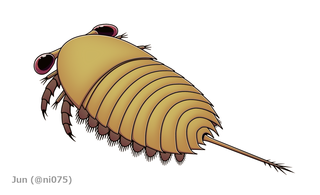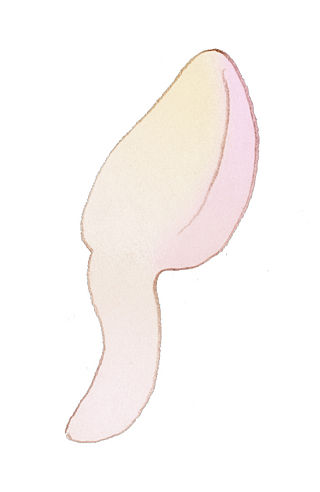
Hallucigenia is a genus of lobopodian, known from Cambrian aged fossils in Burgess Shale-type deposits in Canada and China, and from isolated spines around the world. The generic name reflects the type species' unusual appearance and eccentric history of study; when it was erected as a genus, H. sparsa was reconstructed as an enigmatic animal upside down and back to front. Lobopodians are a grade of Paleozoic panarthropods from which the velvet worms, water bears, and arthropods arose.

Opabinia regalis is an extinct, stem group arthropod found in the Middle Cambrian Burgess Shale Lagerstätte of British Columbia. Opabinia was a soft-bodied animal, measuring up to 7 cm in body length, and its segmented trunk had flaps along the sides and a fan-shaped tail. The head shows unusual features: five eyes, a mouth under the head and facing backwards, and a clawed proboscis that probably passed food to the mouth. Opabinia probably lived on the seafloor, using the proboscis to seek out small, soft food. Fewer than twenty good specimens have been described; 3 specimens of Opabinia are known from the Greater Phyllopod bed, where they constitute less than 0.1% of the community.

Marrella is an extinct genus of marrellomorph arthropod known from the middle Cambrian Burgess Shale of British Columbia. It is the most common animal represented in the Burgess Shale, with tens of thousands of specimens collected. Much rarer remains are also known from deposits in China.

Sanctacaris is a Middle Cambrian arthropod from the Burgess Shale of British Columbia. It was most famously regarded as a stem-group chelicerate, a group which includes horseshoe crabs, spiders and scorpions, although subsequent phylogenetic studies have not always supported this conclusion. Its chelicerate affinities regain support in later observations, alongside the reassignment of Habelia optata as a sanctacaridid-related basal chelicerate. It has been placed as a member of the extinct family Sanctacarididae alongside Wisangocaris and Utahcaris.

Sidneyia is an extinct arthropod known from fossils found from the Early to the Mid Cambrian of China and the Mid Cambrian Burgess Shale of British Columbia, Canada.

Yohoia is an extinct genus of megacheiran arthropod from the Cambrian period that has been found as fossils in the Burgess Shale formation of British Columbia, Canada. The type species, Yohoia tenuis, was described in 1912 by Walcott, who considered it an anostracan crustacean. 711 specimens of Yohoia are known from the Greater Phyllopod bed, where they comprise 1.35% of the community. In 2015, Conway Morris et al. reported another species, Y. utahana, from the Marjum Formation, Utah.

Anomalocaris is an extinct genus of radiodont, an order of early-diverging stem-group arthropods.

Canadaspis is an extinct genus of bivalved Cambrian arthropod, known from North America and China. They are thought to have been benthic feeders that moved mainly by walking and possibly used its biramous appendages to stir mud in search of food. They have been placed within the Hymenocarina, which includes other bivalved Cambrian arthropods.

Leanchoilia is a megacheiran arthropod known from Cambrian deposits of the Burgess Shale in Canada and the Chengjiang biota of China.

Odaraia is a genus of bivalved arthropod from the Middle Cambrian. Its fossils, which reach 15 centimetres (5.9 in) in length, have been found in the Burgess Shale in British Columbia, Canada.

Capsospongia, formerly known as Corralia or Corralio, is a middle Cambrian sponge genus known from 3 specimens in the Burgess shale. Its type and only species is Capsospongia undulata. It has a narrow base, and consists of bulging rings which get wider further up the sponge, resulting in a conical shape. Its open top was presumably used to expel water that had passed through the sponge cells and been filtered for nutrients.

Sarotrocercus is a small Cambrian arthropod known from Burgess shale, reaching a centimetre or two in length (0.39–0.79 in). Sarotrocercus is only known from 7 specimens. It may lie in the arthropod crown group, and a recent study has revised some points of its original description.

Alalcomenaeus is one of the most widespread and longest-surviving arthropod genera of the Early and Middle Cambrian. Known from over 300 specimens in the Burgess Shale and the Chengjiang biota. It is a member of the family Leanchoiliidae in the group Megacheira.

Plenocaris plena is a Cambrian arthropod with a bivalved carapace, and is known from the Burgess shale and Chengjiang. Originally described as a species of Yohoia by Walcott in 1912, it was placed into its own genus in 1974.
Desmond H. Collins is a Canadian paleontologist, associate professor of zoology at the University of Toronto and retired curator of invertebrate paleontology at the Royal Ontario Museum. He is most renowned for his work on the Burgess Shale.

Hurdia is an extinct genus of hurdiid radiodont that lived 505 million years ago during the Cambrian Period. Fossils have been found in North America, China and the Czech Republic.

The Burgess Shale, a series of fossil beds in the Canadian Rockies, was first noticed in 1886 by Richard McConnell of the Geological Survey of Canada (GSC). His and subsequent finds, all from the Mount Stephen area, came to the attention of palaeontologist Charles Doolittle Walcott, who in 1907 found time to reconnoitre the area. He opened a quarry in 1910 and in a series of field trips brought back 65,000 specimens, which he identified as Middle Cambrian in age. Due to the quantity of fossils and the pressures of his other duties at the Smithsonian Institution, Walcott was only able to publish a series of "preliminary" papers, in which he classified the fossils within taxa that were already established. In a series of visits beginning in 1924, Harvard University professor Percy Raymond collected further fossils from Walcott's quarry and higher up on Fossil Ridge, where slightly different fossils were preserved.

Molaria is a genus of Cambrian arthropod, the type species M. spinifera is known from the Middle Cambrian Burgess Shale. 144 specimens of Molaria are known from the Greater Phyllopod bed, where they comprise 0.27% of the community. A second species M. steini was described from the Sirius Passet in Greenland in 2017.

Priscansermarinus barnetti is an organism known from the Middle Cambrian Burgess Shale which was originally interpreted as a species of lepadomorph barnacle. Four specimens of P. barnetti are known from the Greater Phyllopod bed. A reflective area originally interpreted as external plates has been reinterpreted as a more complex structure inside the body; Derek Briggs, a leading authority on the arthropods of the Burgess Shale, has questioned its assignment as a barnacle or even an arthropod. The World Register of Marine Species places Priscansermarinus in Multicrustacea without assigning a class or order.

This is a list of the biota of the Burgess Shale, a Cambrian lagerstätte located in Yoho National Park in Canada.




















